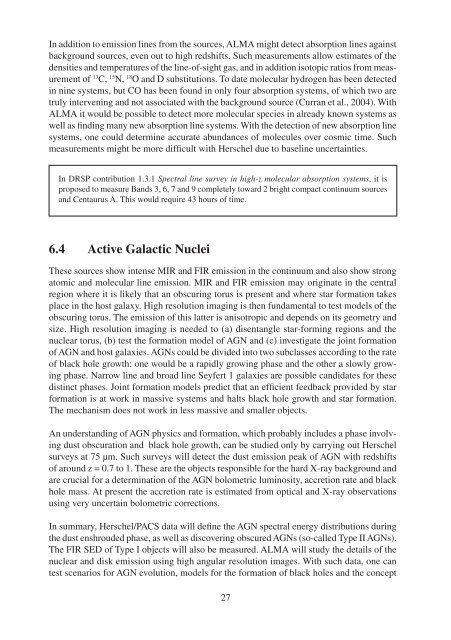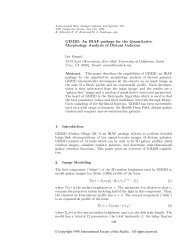4 Comparison of the ALMA and Herschel - ESO
4 Comparison of the ALMA and Herschel - ESO
4 Comparison of the ALMA and Herschel - ESO
Create successful ePaper yourself
Turn your PDF publications into a flip-book with our unique Google optimized e-Paper software.
In addition to emission lines from <strong>the</strong> sources, <strong>ALMA</strong> might detect absorption lines against<br />
background sources, even out to high redshifts. Such measurements allow estimates <strong>of</strong> <strong>the</strong><br />
densities <strong>and</strong> temperatures <strong>of</strong> <strong>the</strong> line-<strong>of</strong>-sight gas, <strong>and</strong> in addition isotopic ratios from measurement<br />
<strong>of</strong> 13 C, 15 N, 18 O <strong>and</strong> D substitutions. To date molecular hydrogen has been detected<br />
in nine systems, but CO has been found in only four absorption systems, <strong>of</strong> which two are<br />
truly intervening <strong>and</strong> not associated with <strong>the</strong> background source (Curran et al., 2004). With<br />
<strong>ALMA</strong> it would be possible to detect more molecular species in already known systems as<br />
well as finding many new absorption line systems. With <strong>the</strong> detection <strong>of</strong> new absorption line<br />
systems, one could determine accurate abundances <strong>of</strong> molecules over cosmic time. Such<br />
measurements might be more difficult with <strong>Herschel</strong> due to baseline uncertainties.<br />
In DRSP contribution 1.3.1 Spectral line survey in high-z molecular absorption systems, it is<br />
proposed to measure B<strong>and</strong>s 3, 6, 7 <strong>and</strong> 9 completely toward 2 bright compact continuum sources<br />
<strong>and</strong> Centaurus A. This would require 43 hours <strong>of</strong> time.<br />
6.4 Active Galactic Nuclei<br />
These sources show intense MIR <strong>and</strong> FIR emission in <strong>the</strong> continuum <strong>and</strong> also show strong<br />
atomic <strong>and</strong> molecular line emission. MIR <strong>and</strong> FIR emission may originate in <strong>the</strong> central<br />
region where it is likely that an obscuring torus is present <strong>and</strong> where star formation takes<br />
place in <strong>the</strong> host galaxy. High resolution imaging is <strong>the</strong>n fundamental to test models <strong>of</strong> <strong>the</strong><br />
obscuring torus. The emission <strong>of</strong> this latter is anisotropic <strong>and</strong> depends on its geometry <strong>and</strong><br />
size. High resolution imaging is needed to (a) disentangle star-forming regions <strong>and</strong> <strong>the</strong><br />
nuclear torus, (b) test <strong>the</strong> formation model <strong>of</strong> AGN <strong>and</strong> (c) investigate <strong>the</strong> joint formation<br />
<strong>of</strong> AGN <strong>and</strong> host galaxies. AGNs could be divided into two subclasses according to <strong>the</strong> rate<br />
<strong>of</strong> black hole growth: one would be a rapidly growing phase <strong>and</strong> <strong>the</strong> o<strong>the</strong>r a slowly growing<br />
phase. Narrow line <strong>and</strong> broad line Seyfert 1 galaxies are possible c<strong>and</strong>idates for <strong>the</strong>se<br />
distinct phases. Joint formation models predict that an efficient feedback provided by star<br />
formation is at work in massive systems <strong>and</strong> halts black hole growth <strong>and</strong> star formation.<br />
The mechanism does not work in less massive <strong>and</strong> smaller objects.<br />
An underst<strong>and</strong>ing <strong>of</strong> AGN physics <strong>and</strong> formation, which probably includes a phase involving<br />
dust obscuration <strong>and</strong> black hole growth, can be studied only by carrying out <strong>Herschel</strong><br />
surveys at 75 µm. Such surveys will detect <strong>the</strong> dust emission peak <strong>of</strong> AGN with redshifts<br />
<strong>of</strong> around z = 0.7 to 1. These are <strong>the</strong> objects responsible for <strong>the</strong> hard X-ray background <strong>and</strong><br />
are crucial for a determination <strong>of</strong> <strong>the</strong> AGN bolometric luminosity, accretion rate <strong>and</strong> black<br />
hole mass. At present <strong>the</strong> accretion rate is estimated from optical <strong>and</strong> X-ray observations<br />
using very uncertain bolometric corrections.<br />
In summary, <strong>Herschel</strong>/PACS data will define <strong>the</strong> AGN spectral energy distributions during<br />
<strong>the</strong> dust enshrouded phase, as well as discovering obscured AGNs (so-called Type II AGNs).<br />
The FIR SED <strong>of</strong> Type I objects will also be measured. <strong>ALMA</strong> will study <strong>the</strong> details <strong>of</strong> <strong>the</strong><br />
nuclear <strong>and</strong> disk emission using high angular resolution images. With such data, one can<br />
test scenarios for AGN evolution, models for <strong>the</strong> formation <strong>of</strong> black holes <strong>and</strong> <strong>the</strong> concept<br />
27




